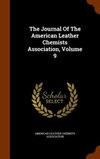使用香蕉(麝香草属)叶中肋单宁鞣制山羊皮的物理特性评估
IF 0.5
4区 工程技术
Q4 CHEMISTRY, APPLIED
Journal of The American Leather Chemists Association
Pub Date : 2024-01-02
DOI:10.34314/jalca.v119i1.8290
引用次数: 0
摘要
多年来,人们一直在研究植物单宁,以减少铬鞣造成的污染负荷。虽然含羞草单宁已被商业化利用,但其价格昂贵且不易获得。这项研究的目的是评估用香蕉叶中肋单宁鞣制的皮革的物理特性,以确定它们是否适合用作植物单宁。研究人员从肯尼亚尼耶里县 Mukurweini 的 Gikondi 村收集了部分香蕉叶中肋样本。这些样品被阴干并磨成粉末。使用林木蕉和'Muraru'(AA 基因组)的香蕉叶中肋单宁,以含羞草为对照,对香蕉皮进行传统加工。按照标准的 IUP 方法测定了所得皮革的物理性质。结果发现,Musa sapenitum Linn、'Muraru'(AA 基因组)和含羞草鞣革的平均收缩温度分别为 80.33 ± 0.74°C、78.67 ± 0.47°C 和 81.67 ± 0.94°C。鞣革的特性与对照鞣革的特性进行了比较。对物理特性的评估表明,这些皮革达到了林麝鞣革的最低安全推荐值,但在 30,000 次弯曲时失效。这些结果表明,香蕉叶中段可用作生产山羊皮皮革的有机鞣剂来源。本文章由计算机程序翻译,如有差异,请以英文原文为准。
Evaluation of the Physical Properties of Goatskins Tanned using Banana (Musa spp.) Leaf Midrib Tannins
Vegetable tannins have been studied over the years with an aim to reduce the pollution load caused by chrome tanning. Although mimosa tannins have been utilized commercially, they are expensive and not readily available. The purpose of this study was to assess the physical properties of leather tanned with banana leaf midribs tannins in order to determine their suitability as vegetable tannins. Selected banana leaf midrib samples were collected from Gikondi village in Mukurweini, Nyeri County, Kenya. They were shade-dried and ground into powder. The skins were processed conventionally using banana leaf midribs tannins of Musa sapientum Linn. and ‘Muraru’ (AA genome), with mimosa as a control. The physical properties of the resultant leathers were determined following the standard IUP methods. It was found that Musa sapenitum Linn, ‘Muraru’ (AA genome) and mimosa-tanned leathers had average shrinkage temperatures of 80.33 ± 0.74°C, 78.67 ± 0.47°C and 81.67 ± 0.94°C, respectively. The properties of the tanned leathers were compared with those of the control-tanned leather. Assessment of the physical properties indicated that the leathers met the minimum recommended values safe for Musa sapentium Linn-tanned leather, which failed at 30,000 flexes. These results indicate that banana leaf midribs can be used as an organic tanning agent source for production of leathers from goatskins.
求助全文
通过发布文献求助,成功后即可免费获取论文全文。
去求助
来源期刊

Journal of The American Leather Chemists Association
工程技术-材料科学:纺织
CiteScore
1.30
自引率
33.30%
发文量
29
审稿时长
3 months
期刊介绍:
The Journal of the American Leather Chemists Association publishes manuscripts on all aspects of leather science, engineering, technology, and economics, and will consider related subjects that address concerns of the industry. Examples: hide/skin quality or utilization, leather production methods/equipment, tanning materials/leather chemicals, new and improved leathers, collagen studies, leather by-products, impacts of changes in leather products industries, process efficiency, sustainability, regulatory, safety, environmental, tannery waste management and industry economics.
 求助内容:
求助内容: 应助结果提醒方式:
应助结果提醒方式:


